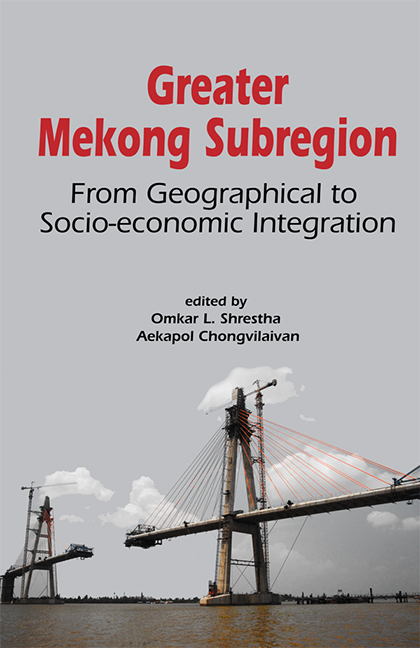Book contents
- Frontmatter
- Contents
- Preface
- List of Abbreviations
- Contributors
- 1 Greater Mekong Subregion: From Geographical Corridors to Socio-economic Corridors
- 2 Cambodia, Its Development, and Integration into the GMS: A Work in Progress
- 3 Subregional Connectivity in the Lao PDR: From Land-locked Disadvantage to Land-linked Advantage
- 4 The Economic Development of Myanmar and the Relevance of the Greater Mekong Subregion
- 5 GMS Challenges for Thailand
- 6 Deepening GMS Cooperation in a More Integrated ASEAN and East Asia
- 7 China (Yunnan)–GMS Economic Cooperation: New Development and New Problems
- 8 Trade and Investment in the Greater Mekong Subregion: Remaining Challenges and the Unfinished Policy Agenda
- 9 Enhancing Financial Cooperation among the GMS Countries
- 10 The Challenges of GMS Regional Integration: Case Study of Governance of the Logistics Industry in Thailand
- 11 Energy Sector Integration for Low-carbon Development in the GMS: Towards a Model of South-South Cooperation
- 12 Linking the Social to the Economic: Broadened Ambitions and Multiple Mitigations in New Mekong Corridors
- Index
6 - Deepening GMS Cooperation in a More Integrated ASEAN and East Asia
Published online by Cambridge University Press: 21 October 2015
- Frontmatter
- Contents
- Preface
- List of Abbreviations
- Contributors
- 1 Greater Mekong Subregion: From Geographical Corridors to Socio-economic Corridors
- 2 Cambodia, Its Development, and Integration into the GMS: A Work in Progress
- 3 Subregional Connectivity in the Lao PDR: From Land-locked Disadvantage to Land-linked Advantage
- 4 The Economic Development of Myanmar and the Relevance of the Greater Mekong Subregion
- 5 GMS Challenges for Thailand
- 6 Deepening GMS Cooperation in a More Integrated ASEAN and East Asia
- 7 China (Yunnan)–GMS Economic Cooperation: New Development and New Problems
- 8 Trade and Investment in the Greater Mekong Subregion: Remaining Challenges and the Unfinished Policy Agenda
- 9 Enhancing Financial Cooperation among the GMS Countries
- 10 The Challenges of GMS Regional Integration: Case Study of Governance of the Logistics Industry in Thailand
- 11 Energy Sector Integration for Low-carbon Development in the GMS: Towards a Model of South-South Cooperation
- 12 Linking the Social to the Economic: Broadened Ambitions and Multiple Mitigations in New Mekong Corridors
- Index
Summary
Thanks to various measures for domestic economic reforms and regional economic integration, the East Asian economies in general, and the Association of Southeast Asian Nations (ASEAN) member economies in particular, have seen themselves becoming more deeply connected. Economic activities, particularly trade and investment activities, experienced a drastic increase in almost all sectors and all parts of the region. Cooperation between East Asian economies has also been enhanced, with the initial views to facilitating smoother flows of trade, investment, and labour, and eventually to joining hands in coping with more regionally common issues that arose in recent years.
In such a context, the Greater Mekong Subregion (GMS), with members Cambodia, the People's Republic of China (specifically Yunnan Province and Guangxi Zhuang Autonomous Region), the Lao People's Democratic Republic (PDR), Myanmar, Thailand, and Vietnam, is becoming an important and dynamic region. With assistance from the Asian Development Bank (ADB) in 1992, the six GMS countries launched a programme of subregional economic cooperation to enhance their economic relations, building on their shared histories and cultures, and covering priority sectors such as agriculture, human resource development, etc. Along with ASEAN integration and ASEAN-plus integration, economic integration under the GMS framework has also been rapid. This broadens the development opportunities for each member country while facilitating their joint efforts in a rising subregion with a relatively smaller development gap.
Nonetheless the GMS economies face a number of challenges in their integration and development processes. The challenge comes first from their low income levels, such as those prevailing in Cambodia, the Lao PDR, and Myanmar. Their economies also differ significantly in terms of labour and industrial structures. The gap in institutional settings across the GMS economies, which puts different constraints and presents various economic and integration-facilitating ingredients, is another source of difference. In the new development context, GMS economies, as part of the dynamic East Asia, encounter to a larger extent non-traditional security issues, such as food security, climate change, among others. As these are major impediments to GMS cooperation, they necessitate bolder and more effective measures to resolve them.
This chapter attempts to discuss the context of, and policy recommendations for, deepening GMS cooperation. Apart from the introduction, it consists of four sections.
- Type
- Chapter
- Information
- Greater Mekong SubregionFrom Geographical to Socio-economic Integration, pp. 84 - 102Publisher: ISEAS–Yusof Ishak InstitutePrint publication year: 2013



